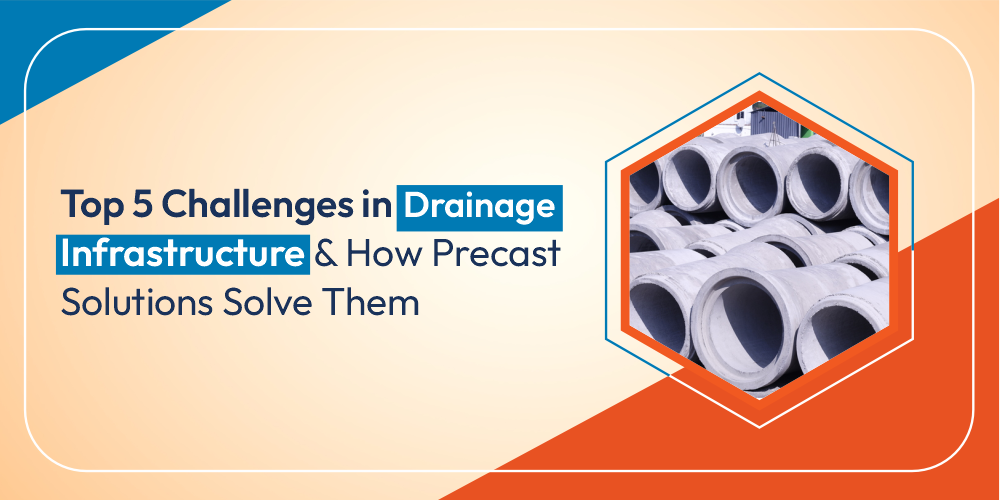The importance of effective drainage infrastructure cannot be overstated in modern urban development. Proper drainage systems ensure the prevention of waterlogging, reduce the risk of flooding, and protect public health by removing wastewater efficiently. However, there are several challenges that consistently impact the design, construction, and maintenance of drainage systems. In this blog, we will explore the top five challenges faced by the drainage infrastructure industry and how precast solutions are emerging as effective solutions to address these issues.
1. Aging Infrastructure and Maintenance Challenges
The Problem:
A significant portion of the drainage infrastructure in many cities, particularly in developed nations, is aging. According to a report by the American Society of Civil Engineers (ASCE), nearly 60% of the United States’ underground water and wastewater infrastructure is more than 40 years old. This aging infrastructure presents various challenges, including frequent blockages, structural failures, and inefficiency in stormwater management.
The Solution:
Precast concrete systems offer a timely solution by replacing or supplementing deteriorating infrastructure. These systems are built to last, with a design life of 50+ years, making them ideal for long-term drainage infrastructure projects. Furthermore, precast products are manufactured in controlled environments, ensuring high quality and durability, which directly addresses the issue of material degradation often seen in traditional construction methods.
2. Increased Urbanization and Flooding Risks
The Problem:
Urbanization leads to the replacement of natural soil with impervious surfaces like asphalt and concrete. This, in turn, reduces the ground’s ability to absorb water, leading to an increased volume of surface runoff. Cities around the world, from New York to Mumbai, are grappling with the challenge of managing stormwater efficiently, which often results in flooding during heavy rainfall events.
The Solution:
Precast drainage systems, especially those with built-in features like rainwater harvesting or infiltration systems, are designed to handle increased runoff efficiently. Precast systems are modular, allowing for rapid installation and adaptability in response to changing urban landscapes. For instance, in Singapore, precast drainage systems have been integrated into the city’s design to mitigate the impacts of increased rainfall due to climate change.
3. Sustainability and Environmental Impact
The Problem:
As the world becomes more conscious of environmental issues, there is a growing demand for sustainable drainage solutions. Traditional concrete drainage infrastructure can be resource-intensive and has a significant carbon footprint. Furthermore, improper drainage systems can lead to the contamination of water bodies, negatively impacting ecosystems.
The Solution:
Precast drainage systems are often designed with sustainability in mind. They can be made from recycled materials, such as industrial by-products or waste concrete, reducing the demand for virgin resources. Additionally, the precast process allows for precision engineering, meaning fewer material wastages. In the UK, the use of precast systems for stormwater management has significantly reduced environmental impacts compared to traditional cast-in-place methods.
4. Installation Time and Cost
The Problem:
Time is a critical factor when constructing drainage systems, especially in areas with heavy traffic or where construction delays can cause major disruptions. The labor-intensive nature of traditional drainage construction, along with the need for on-site curing, results in prolonged project timelines and higher costs.
The Solution:
One of the most significant advantages of precast solutions is the speed of installation. Precast components are factory-made and pre-assembled, meaning that they are ready for installation as soon as they arrive on site. This reduces the need for on-site labor, minimizes delays, and ultimately lowers project costs. In projects like the Hong Kong International Airport Drainage System, precast drainage pipes were used to reduce installation time by more than 30%.
5. Design Complexity and Customization
The Problem:
The design of drainage infrastructure is highly specific to the local environment. Factors like soil composition, water flow patterns, and regional climate conditions all need to be taken into account. Custom-designed solutions are often required, but traditional construction methods can be limiting in terms of flexibility and precision.
The Solution:
Precast drainage systems offer significant flexibility in design and customization. Manufacturers can produce components that are tailored to meet specific site requirements, ensuring that the system performs optimally. With the ability to create bespoke solutions, such as sloped trench systems or specially designed drainage chambers, precast concrete addresses the complex nature of modern drainage design. In places like Dubai, where extreme temperatures and high groundwater levels are common, customized precast solutions are used to ensure efficient drainage performance.
Conclusion
The challenges faced by drainage infrastructure are significant, but with the adoption of precast solutions, many of these problems can be alleviated. Precast concrete systems provide long-lasting, sustainable, and cost-effective solutions that help cities manage stormwater, improve efficiency, and ensure public safety. By addressing aging infrastructure, urbanization issues, environmental concerns, and design complexities, precast solutions are paving the way for smarter, more resilient drainage systems worldwide.

